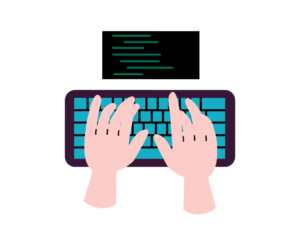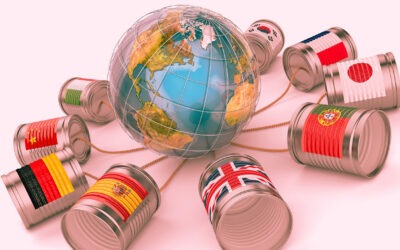Part 1
“A copy editor’s work is largely invisible, until she misses something, in which case she takes the blame.”
Merrill Perlman
This quote is a good reflection when we talk about machine translation post-editing, better known as MTPE, and “blame” kind of sets the tone for our analysis.
Thanks to today’s extraordinary advances in artificial intelligence and its awesome machine learning features, this is a hot topic, especially for language service professionals, such as translators, proofreaders, transcreators and localizers and, of course, copywriters and text editors.

Although human professionals remain of the utmost importance in the translation process, the advances in equipment and constantly evolving algorithms have allowed machine translation to take on the market at an alarming rate, becoming the controversial subject of the moment.
We can define machine translation, or MT, as translation made by specialized software from one natural language to another natural language based on certain rules, patterns, and statistics, with no human intervention.
Machine translation is now reaching very acceptable quality levels, which represents a double benefit for the client—high speed combined with increasing quality—and a major challenge for the translator—the fear of becoming redundant and, to those refusing to miss this journey into the future, the difficulty in getting fair compensation for the effort that goes into post-editing.
So, what is the role of translation professionals in MT?

When companies opt for machine translation, human professionals perform the so-called machine translation post-editing (MTPE), a kind of fusion between the accuracy of human translation and the speed of machine translation, ensuring quality results.
A professional who works on post-editing is called a “post-editor.”
Post-editing in general (not just in machine translation or AI copywriting processes) is the improvement of a translation or copy by making further changes to a text after it has already gone through some level of verification, correction, and improvement.
Ideally, machine translation post-editing would consist of improving the results obtained with software, but with minimum manual work.
Is this what happens in reality? We will explore the issue further below.
And what’s the difference between proofreading and post-editing?

A proofreader detects and corrects spelling and punctuation errors, and inconsistencies, while an editor corrects actual writing problems such as sentence construction, clarity, context, and language style.
As a rule, the degree of difficulty in the post-editor’s work will be proportional to the translator’s skills and experience, whereas in the case of machine translation, only a thorough and competent post-editing will ensure good quality results, with the best readability and clarity, as well as the right tone of voice.
Types of MTPE and post-editing strategies
The post-editing process depends on the client’s expectations, which should always be set forward beforehand.
The main points to discuss beforehand are time, price, and quality, as these will determine the type strategies the post-editor will use in their work.
-
Light post-editing
The client wants a final translation of acceptable quality; he wants as few edits as possible to be made to the machine translation to obtain a result that is readable with a satisfactory degree of accuracy; he favors a fast and economical service.
-
Full post-editing
The client wants a high-quality final translation; they want a thorough review of the machine translation and expect the post-editor to improve grammar, consistency, tone, style, and speech appropriateness; they want the text to sound natural and fluid; they are willing to pay for the quality they want. It should be confirmed with the client whether there is freedom to ignore MT when it doesn’t seem suitable and translate freely.
The professional’s approach to a full post-editing will obviously be much slower and therefore also more expensive than a light post-editing. The specific project strategy must be adapted to the client’s expectations regarding time, cost, and quality.

Of course, other options can be agreed upon so that the service is rewarding for both parties, such as prioritizing only certain segments of greater importance or value by reviewing them more thoroughly and giving the remaining content a lighter reading.
It can be tempting for clients to forgo post-editing altogether, which might not be entirely disastrous depending on the content of the materials.
For example, it may be internal documents that will not be read by anyone outside the company, and you only want employees to understand the information in broad terms.
If we have a very simple source text in terms of sentence structure about common topics, or when we have a relatively simple technical text with a good terminology database, the probability of getting bad translations from the AI is low.
However, you’d think that companies that regularly need translations would know that while MT has improved astonishingly in recent years, it still cannot compare to the accuracy of human translators.
It’s clear that, apart from the few exceptions we have just mentioned, discarding the post-editing of machine translation is a mistake that could cost the client much more than what they would have paid to a skilled professional! This is why many companies are now turning to post-editors because they know that nothing beats the sensitivity, flexibility, and accuracy of human linguists.
It’s true that using machine translation speeds up the process compared to a human translator, especially in the case of high volume and repetitive translations, but nothing compares to a human editor to ensure that the resulting work is error-free and consistent.
A translator who uses MT to instantly translate large volumes of text, only as a typing aid, is left with more free time to focus on the small details and creative elements, perfecting the text in post-editing.
For the client:
🥇The machine translation software must be of good quality. Also, if you have texts with confidential information or personal data, think about the privacy issues when using generic free translators like Google Translate. You should keep in mind that MTPE is not suitable for some language pairs (more popular language pairs will have a better machine translation engine and vice versa) and for some areas of specialization.
🥇 The original text to be machine translated must be free of grammar or spelling mistakes, and should be written in a clear, concise, fluid, and consistent way. Therefore, prepare the text before MT, format it carefully and correct any errors and inconsistencies—the better you prepare the content before translation, the better the result will be and the shorter the lead time.
🥇 Avoid overly complex sentences and unnecessary frills. Ideally, use short sentences, with a maximum of 20 words. Remember, for a better AI translation, the text should be straight to the point and uncomplicated.
🥇 Dubious information should be written out in full—for example, dates, which can have different formats depending on the country.
🥇 If you want to translate texts with specific technical terminology, provide the post-editor with a glossary so that they can create a database and make inconsistent AI translations uniform. Here are some tips to keep in mind when writing a text for MTPE:
- The sentence structure should be the simplest and most obvious: subject > verb > object
- Use the active voice rather than the passive
- Avoid words with multiple meanings
- Use simple grammar
- Write short sentences
- Avoid sarcasm and irony
For the post-editor:
🥇Post-editors should be careful not to over or under-edit. Under-editing can produce a result that’s riddled with spelling, grammatical or interpretation errors. On the other hand, over-editing—preferential or stylistic edits or a much more detailed editing than what the client intended—will create problems such as missed deadlines, the price paid by the client not compensating the work performed … basically giving the editor one of those headaches. So, if it’s not a mistake, don’t touch it; if the sentence structure is correct and the meaning is understandable, don’t waste your time!
🥇 Post-editing should be based on a process of analysis and discussion involving the post-editor and the client and, if possible, the writer of the source copy. The machine translated source must be suitable for MTPE, the human professional should be aware of the client’s expectations before accepting the task and the agreed price should compensate for the level of detail required. This will save both the client and the human translator a lot of headaches.

High-quality machine translation depends as much on effective AI output as on human intelligence and effort. 🤝
This brain work involves not only the post-editing itself, but also the revision or preparation of source texts, possibly the creation of a database, and more or less extensive post-editing work.
And we dare say that it wouldn’t hurt to have some experience in MTPE. A post-editor should consider all of the above, but it’s also important to be aware of the MT weaknesses, its usual “vices,” because only then will they be able to detect the nuances that will easily escape the less forewarned.
Reading suggestions:
👉🏼 https://cdt.europa.eu/en/light-post-editing-neural-machine-translation-output
Verbarium offers professional MTPE services tailored to your needs. Do not hesitate to contact us if you have any questions about the process.
Don’t miss the conclusion of this article here.






0 Comments